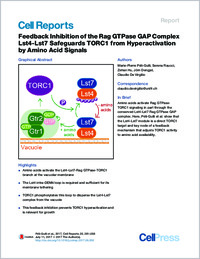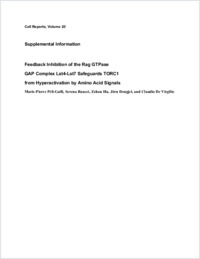Feedback inhibition of the Rag GTPase GAP complex Lst4-Lst7 safeguards TORC1 from hyperactivation by amino acid signals
- Péli-Gulli, Marie-Pierre Department of Biology, University of Fribourg, Switzerland -
- Raucci, Serena Department of Biology, University of Fribourg, Switzerland -
- Hu, Zehan Department of Biology, University of Fribourg, Switzerland
- Dengjel, Jörn Department of Biology, University of Fribourg, Switzerland
- De Virgilio, Claudio Department of Biology, University of Fribourg, Switzerland -
-
11.07.2017
Published in:
- Cell Reports. - 2017, vol. 20, no. 2, p. 281–288
English
Amino acids stimulate the eukaryotic target of rapamycin complex 1 (TORC1), and hence growth, through the Rag GTPases and their regulators. Among these, the yeast Lst4-Lst7 Rag GTPase GAP complex clusters, as we previously reported, at the vacuolar membrane upon amino acid starvation. In response to amino acid refeeding, it activates the Rag GTPase-TORC1 branch and is then dispersed from the vacuolar surface. Here, we show that the latter effect is driven by TORC1 itself, which directly phosphorylates several residues within the intra-DENN loop of Lst4 that, only in its non-phosphorylated state, tethers the Lst4-Lst7 complex to the vacuolar membrane. An Lst4 variant disrupting this feedback inhibition mechanism causes TORC1 hyperactivation and proliferation defects in cells grown on poor nitrogen sources. Thus, we identify Lst4 as a TORC1 target and key node of a homeostatic mechanism that adjusts TORC1 activity to the availability of amino acids.
- Faculty
- Faculté des sciences et de médecine
- Department
- Département de Biologie
- Language
-
- English
- Classification
- Biological sciences
- License
- License undefined
- Identifiers
-
- RERO DOC 305038
- DOI 10.1016/j.celrep.2017.06.058
- Persistent URL
- https://folia.unifr.ch/unifr/documents/306046
Other files
Statistics
Document views: 64
File downloads:
- vir_fir.pdf: 163
- vir_fir_sm.pdf: 112

